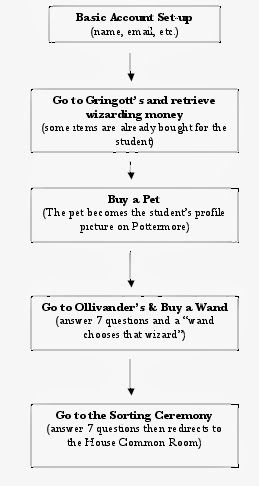So
now we have come to the end of the year and the House Cup needs awarding. It
has been a fascinating study and it is time to wrap up the findings.
So, here it goes. To start off I would like to discuss
the role of online gaming. Pottermore is not your typical online game with
tasks of the shoot 'em sort or anything like that. It is a primarily single
player game (we'll get into how it is not single later!) with a more exploring
goal in mind. A. J. Robison wrote that most games succeed with goals that the
player can achieve and thereby gain a sense of "a 'win' state" (361).
Pottermore is an affinity space (Ellcessor & Duncan) which revolves around
the ideas of online games as well as the wonderful world of Harry Potter but it
lacks that customary "win state" that most games offer. Pottermore
works in a different realm and instead gives the player a wealth of information
about the world of Harry Potter as well as a way to continue to access the
fantasy that Harry Potter created regardless that the series has ended. The
site allows it players to engage in that particular fantasy world and
"players' interpretations of games are just one part of the meaning-making
conversations that occur between readers and writers," (Robison 361).
Everything that we do online (and arguably offline as well) is part of a larger
picture. We are in conversation with other pieces of text that we have read,
things that we are writing, and those that we have yet to read. The online
aspect of Pottermore simply offers a multi-modal environment for further
expression and adventure into the fandom and fiction of Harry Potter.
In
David Buckingham and Andrew Burn's article "Game Literacy in Theory and
Practice" (2007), they wrote, "computer games are almost invariably
multi-modal texts (Kress and van Leewen, 2001) - which is to say that they
often combine different communicative modes, such as still and moving images,
sounds and music, speech and writings, and so on," (326). Pottermore does
all of the above. There are multiple ways to engage with the game. I found the
communicative properties of the game the most interesting of course and so
focused much of my research on that particular aspect while studying the site.
Within the game, there are two features that allow the single-player to
interact with others (thus the above mention of "primarily"
single-player functionality). The chat feed feature allowed for real-time
conversations to happen between players, albeit in a limited capacity. This
feature is also the primary area for players of Pottermore to create an
identity for themselves. So at this point, I think it is relevant to take
a look at the initial set-up of a Pottermore account and the personalization
features it offers it students. The following flow chart follows the initial
steps to becoming a Pottermore student.
 |
| Flow Chart Process of Pottermore Account Set-up |
As
you can see, the site is very restricting in its personalization features and
so the main way that players get to personalize and create identity is through
the conversations that they have through the Great Hall and Common Room chat
feeds.
Their identity was sculpted through their chats with
other students. In Yong Jin Park's article "Digital Literacy and Privacy
Behaviors Online" (2011), the author did extensive research into how
people viewed and demonstrated online privacy behaviors. Park wrote,
"there was evidence that in personal privacy (Turow & Hennessy, 2007)
offline status, such as age, gender, income, and education, affects privacy
protection behavior," (220). I found this applicable to Pottermore in a
few ways. Identity is a very tricky thing to pinpoint. Everyone, whether
consciously or not, creates for themselves an identity when they are in an
online space. Language, tone, grammar, and other language aspects all create a
sense of who the author is or wants to be seen as being. Pottermore is a very
restrictive site at least in the privacy settings and ability to create an
identity. Therefore, players have to go out of their way to specifically create
an identity. They used tag names on the end of their messages, they used
specific Harry Potter book references to create an online enactment of specific
book events, they also had inside jokes, and perhaps pet names or codes to
communicate with each other. All of these could be seen by anybody but the way
they crafted their interactions was very exclusive to those who were not in
that particular group. Their "privacy" was created through how they
used the public chat feature of the game.
I feel that their "ecology of practice"(Buck
9 & 13), or how that was part of their online game playing, is an important
aspect of how Pottermore really (perhaps unknowingly) created a special place
for those players to create an identity and an online presence that allowed them
to explore Harry Potter and its fandom in a more in depth way than most would
expect of such a site. Their play on Pottermore was fascinating to watch unfold
in how they utilized the limited space of the restrictive site to create
identity and communicate with others about similar interests and fulfill their
fan enthusiasm for Harry Potter.
Back in the early stages of the study, I created data analysis posts to emphasize some of identity markers that I had found in the research of Pottermore. So to save you the time of reading old posts again, here are a few charts to describe the data I found.
 |
|
This data set brings up some
fascinating information about how students interacted in their own Houses
(especially compared to the open chat between the Houses in the Great Hall,
more about that later!). This space offered the students a place to openly
communicate with their fellow House members. Newbies were accepted as new House
members and on some occasions were given pointers (not shown in this data set).
They were comfortable enough though to correct themselves. This may not be the
case in more open environments for reasons such as embarrassment or hesitation
to use that space in the first place. I also found it interesting that students
discussed non-Pottemore material in this chat feed. One student commented about
writing their own fanfiction about the world of Harry Potter. It seems then
that the House Common Room chat operates similarly to how a real common room
would. The participants are open and feel at least a moderate sense of comfort
and the ability to communicate with others. The topics are open as well
especially given the odd posts directed at the creators of the site to add a
special chat feature that allowed more privacy between just friends (students
can friend each other just like on Facebook in Pottermore).
So then, this brings up some other interesting points
when put in conjunction with data set #2.
This brings up a few points on
this issues from A. J. Robison’s article that games are “multimodal,
multi-dimensional, interactive, experiential “text” that will likely be
interpreted in complex, often unanticipated ways,” (361). She further explores
the idea of complex issues with gaming interpretation in her summarization of
how a game writer knows that the game he/she produces will not be seen in the
same context as how that game was originally intended to be seen (362). Players all
bring something different to their game experience and so that creates another
aspect of how identity and games interact in the online world.

Identity is created through
how players interact with each other and game interface online. Their personal
experiences influence how they react and create meaning within the game. It
also affects how they will interpret the game and how they will use the
available features of said game to create meaning for themselves and for those
around them in the virtual world. Pottermore, though restrictive in its
personalization features, nevertheless allows its players to explore an amazing
world of online communication and interaction through its chat features. It
creates and builds an identity for those players and it allows them to explore
Pottermore through a different light than the creators perhaps had intended.
Identity is the key to every online (and arguably offline) interaction and how
that is shaped and expressed is important because it defines who we are.
So, I hope you all have had a
good time reading about this project. The House Cup goes to you...
Bibliography
Black, Rebecca and Constance Steinkuehler. "Literacy in Virtual Worlds." Eds. L. Christenbury, R. Bomer, & P. Smagorinsk. New York: Guilford, 2009. 271-286. Print.
Buck, Amber. "Examining Digital Literacy Practices on Social Network Sites." Research in the Teaching of English 47.1 (2012): 9-38. Web. November 10th, 2013.
Buckingham, David and Andrew Burn. "Game Literacy in Theory and Practice." Journal of Educational Multimedia and Hypermedia 16.3 (2007). 323-349. Print.
Ellcessor, Elizabeth and Sean C. Duncan. "Forming The Guild: Star Power and Rethinking Projective Identity in Affinity Spaces." International Journal of Game-Based Learning (n/a) (2011).
Henkin, Roxanne, Janis Harmon, Elizabeth Pate, and Honor Moorman. Editorial. "Merging Literacy and Technology." Voices from the Middle. March 2010: 1.3. Print.
Park, Yong Jin. "Digital Literacy and Privacy Behavior Online." Communication Research 40.215 (2013): (n/a). Web. November 10th, 2013.
Robison, Alice. "The Design is the Game: Writing Games, Teaching Writing." Computers and Composition 25 (2008). 359-370. Web. November 10th, 2013.
J.K. Rowling's Harry Potter series
Images borrowed from:






